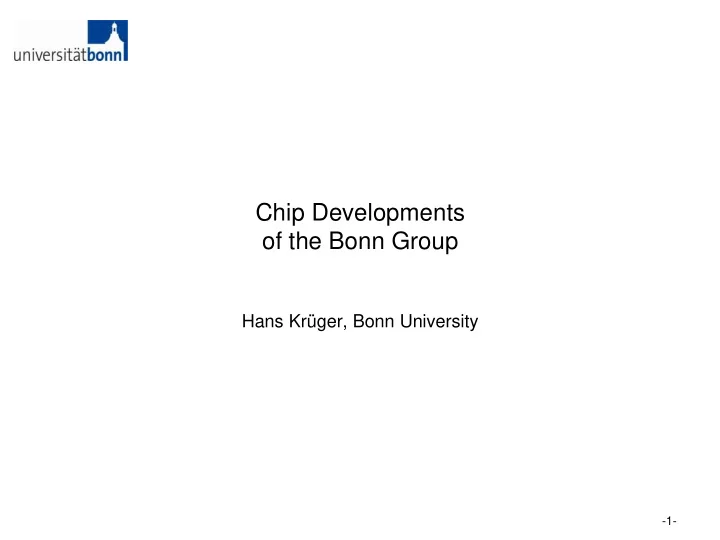

Chip Developments of the Bonn Group Hans Krüger, Bonn University -1-
ASIC Design Projects • ATLAS Pixel Detector – Hybrid pixel sensors • FE-I3 (250nm, current pixel detector) • FE-I4 (130nm, Insertable B-layer, current upgrade) done • FE-x (65nm, future HL upgrade, RD53 collaboration) work just started – Fully depleted Active CMOS Sensors (DMAPS) • Commercial CMOS technology for the sensing layer, monolithic or hybrid HL upgrade option • Belle II Pixel Vertex Detector (SuperKEKB e+ / e- collider) – Digital signal processing on pixel module (65nm, DHP chip) (alomost) done • 1.6GHz PLL • High speed serial links • High density digital signal processing • Low power, high density 10 Msps 8-bit ADC • X-ray imaging (low energy, synchrotron light sources, X-FEL) – AGIPD (130nm hybrid pixel detector, XFEL@DESY) – New developments: monolithic or hybrid with active CMOS sensors H. Krüger,Bonn University, RD53 WG 1 Meeting, 18.12.2013 -2-
65nm CMOS Design Activities – Belle II Projects • DEPFET Pixel Vertex Detector for BELLE II (2015) Data handling processor (DHP), mainly digital design, including full custom blocks: – PLL (1.6 GHz) – High speed serial link (1.6 Gbps) – LVDS IO • „Generic“ (future pixel chips) – Low power analog front-end (CSA + discr.) – Low power, small area ADC – SEU test structures Chip submissions • DHPT 0.1, four chiplets, Oct. 2011 • DHPT 0.2, four chiplets, June 2012 • DHPT 1.0 – 14 mm 2 MPW – C4 bumps H. Krüger,Bonn University, RD53 WG 1 Meeting, 18.12.2013 -3-
Chip Design Activites – RD53 • Focused on 65nm CMOS technology for HL pixel detector upgrades • Joint CMS/ATLAS (+CLIC) development • RD53 collaboration recommended by LHCC June 2013 – Institutes: 17 (+ 3 new applicants) • ATLAS: CERN, Bonn, CPPM, LBNL, LPNHE Paris, NIKHEF, New Mexico, RAL, UC Santa Cruz. • CMS: Bari, Bergamo-Pavia, CERN, Fermilab, Padova, Perugia, Pisa, PSI, RAL, Torino. – Collaborators: ~100, ~ 50% chip designers – Initial work program covers ~3 years to make foundation for final pixel chips – Co-spokes persons: ATLAS: M. Garcia-Sciveres, LBNL. CMS: J. Christiansen, CERN • RD53 web: www.cern.ch/RD53/ H. Krüger,Bonn University, RD53 WG 1 Meeting, 18.12.2013 -4-
RD53 Working Groups H. Krüger,Bonn University, RD53 WG 1 Meeting, 18.12.2013 -5-
• Backup H. Krüger,Bonn University, RD53 WG 1 Meeting, 18.12.2013 -6-
PLL & High Speed Link Driver • PLL – 80 MHz reference clock – 1.6 GHz, 800MHz & 320 MHz outputs • Pseudo random bit sequence generator (8 bit LFSR) • Current mode logic (CML) driver – Programmable pre-emphasis (first order FIR filter) – Two differential pairs with adj. bias currents (tap weights a, b) – Programmable delay dt PLL_CML Test Chip, T. Kishishita 320 MHz CML TXO_P TXO_N driver 320 MHz CML driver 50 50 800 MHz TX1_P PLL 80 MHz TX1_N 1.6 GHz pre LFSR drv. I 0 I 1 del 2 dt a b H. Krüger,Bonn University, RD53 WG 1 Meeting, 18.12.2013 -7-
Layouts 140um CP PFD 55um PLL LPF DIV VCO 105 µm Predriver circuit Decoupl. C 75 µm CML driver poly-res. with dummy structures T. Kishishita H. Krüger,Bonn University, RD53 WG 1 Meeting, 18.12.2013 -8-
Gbit Link Test Setup Signal Integrity Analysis Flex cable, TWP cable, 38cm 10 (20) m DHPT 0.1 H. Krüger,Bonn University, RD53 WG 1 Meeting, 18.12.2013 -9-
Signal Integrity Analysis • 1.6 Gbps, 8bit LFSR sequence • 10m Infiniband cable (LEONI, AWG 26) 400 mV 600 mV Preemphasis off Preemphasis on (600ps, max. I boost ) H. Krüger,Bonn University, RD53 WG 1 Meeting, 18.12.2013 -10-
Low Power ADC 8bit ADC 10 Msps Charge redistribution Asynchronous operation low power No clock distribution needed Sample signal triggers digitization sequence Serial LVDS data out T. Hemperek, T. Kisisita Asynchronous ADC timing Function Diagram H. Krüger,Bonn University, RD53 WG 1 Meeting, 18.12.2013 -11-
ADC Layout Straight DAC Folded DAC ADC area dominated by DAC 40 um 30 um Switched capacitor DAC layout critical for DNL performance 8 bit 7 bit: half size 70um DAC D 120 um A C H. Krüger,Bonn University, RD53 WG 1 Meeting, 18.12.2013 -12-
Asynchronous ADC Measurements Single Ended Mode Differential Mode • Measured at 10 MHz sample rate • Power consumption: ~40uW • Works up to 12.5 Msps H. Krüger,Bonn University, RD53 WG 1 Meeting, 18.12.2013 -13-
Recommend
More recommend